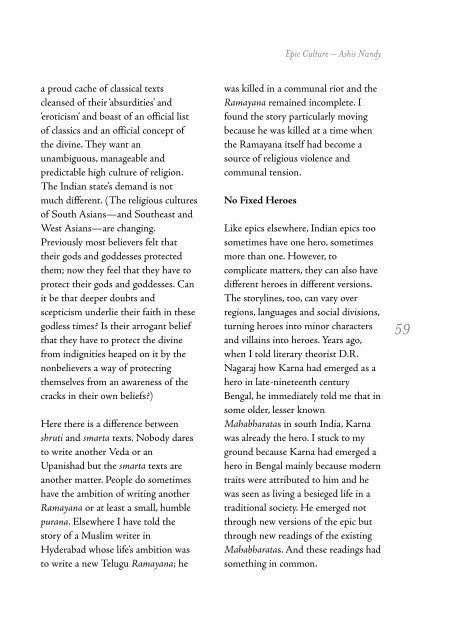Layout 3 - India Foundation for the Arts - IFA
Layout 3 - India Foundation for the Arts - IFA
Layout 3 - India Foundation for the Arts - IFA
You also want an ePaper? Increase the reach of your titles
YUMPU automatically turns print PDFs into web optimized ePapers that Google loves.
a proud cache of classical texts<br />
cleansed of <strong>the</strong>ir ‘absurdities’ and<br />
‘eroticism’ and boast of an official list<br />
of classics and an official concept of<br />
<strong>the</strong> divine. They want an<br />
unambiguous, manageable and<br />
predictable high culture of religion.<br />
The <strong>India</strong>n state’s demand is not<br />
much different. (The religious cultures<br />
of South Asians—and Sou<strong>the</strong>ast and<br />
West Asians—are changing.<br />
Previously most believers felt that<br />
<strong>the</strong>ir gods and goddesses protected<br />
<strong>the</strong>m; now <strong>the</strong>y feel that <strong>the</strong>y have to<br />
protect <strong>the</strong>ir gods and goddesses. Can<br />
it be that deeper doubts and<br />
scepticism underlie <strong>the</strong>ir faith in <strong>the</strong>se<br />
godless times? Is <strong>the</strong>ir arrogant belief<br />
that <strong>the</strong>y have to protect <strong>the</strong> divine<br />
from indignities heaped on it by <strong>the</strong><br />
nonbelievers a way of protecting<br />
<strong>the</strong>mselves from an awareness of <strong>the</strong><br />
cracks in <strong>the</strong>ir own beliefs?)<br />
Here <strong>the</strong>re is a difference between<br />
shruti and smarta texts. Nobody dares<br />
to write ano<strong>the</strong>r Veda or an<br />
Upanishad but <strong>the</strong> smarta texts are<br />
ano<strong>the</strong>r matter. People do sometimes<br />
have <strong>the</strong> ambition of writing ano<strong>the</strong>r<br />
Ramayana or at least a small, humble<br />
purana. Elsewhere I have told <strong>the</strong><br />
story of a Muslim writer in<br />
Hyderabad whose life’s ambition was<br />
to write a new Telugu Ramayana; he<br />
Epic Culture – Ashis Nandy<br />
was killed in a communal riot and <strong>the</strong><br />
Ramayana remained incomplete. I<br />
found <strong>the</strong> story particularly moving<br />
because he was killed at a time when<br />
<strong>the</strong> Ramayana itself had become a<br />
source of religious violence and<br />
communal tension.<br />
No Fixed Heroes<br />
Like epics elsewhere, <strong>India</strong>n epics too<br />
sometimes have one hero, sometimes<br />
more than one. However, to<br />
complicate matters, <strong>the</strong>y can also have<br />
different heroes in different versions.<br />
The storylines, too, can vary over<br />
regions, languages and social divisions,<br />
turning heroes into minor characters<br />
and villains into heroes. Years ago,<br />
when I told literary <strong>the</strong>orist D.R.<br />
Nagaraj how Karna had emerged as a<br />
hero in late-nineteenth century<br />
Bengal, he immediately told me that in<br />
some older, lesser known<br />
Mahabharatas in south <strong>India</strong>, Karna<br />
was already <strong>the</strong> hero. I stuck to my<br />
ground because Karna had emerged a<br />
hero in Bengal mainly because modern<br />
traits were attributed to him and he<br />
was seen as living a besieged life in a<br />
traditional society. He emerged not<br />
through new versions of <strong>the</strong> epic but<br />
through new readings of <strong>the</strong> existing<br />
Mahabharatas. And <strong>the</strong>se readings had<br />
something in common.<br />
59


